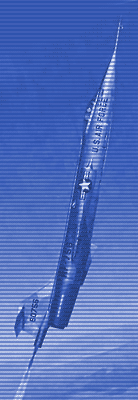The Mission > home

|
|
|
|
|
|
 |
The Mission click on the links below for more of the story...
|
17 What’s in the Future?Under the circumstances at the time, the wisest move may have been to cancel the AST after the accident, if for no other reason, than X-20 was dead and with it the future of Air Force flying airplanes in space, even now. I have a certain fondness for the AST program and truly enjoyed my flying it, until the drudgery and uselessness of the many flights after Yeager’s accident. Including later flights to gather stability data in the 70,000 to 80,000 regions. There was some risk and some offer of discovering new and useful data for some future use. And that is what experimental test flying is all about. I had thought for some time about writing the story of the AST because the folks who designed, built and supported it did such an unusual thing, and I think did it well. The airplane and the people deserved some recognition of that, long ago. Recently, I was contacted by some friends who are excellent engineers and scientists who didn’t know I was writing but wanted information about AST for a DARPA program which is funded to study the use of an existing modern fighter, modified to do precisely what we did with AST, only twice as high and faster and for an extremely valuable and useful purpose. I must say that realization has encouraged me to finally write this. Only now are they looking at advanced versions of modern and similarly modified fighter aircraft to efficiently place satellites in full earth orbit for a fraction of today’s cost for expendable rocket launch and orbital insertion. The combination of the currently existing technology and lightweight, high-technology satellites may make far more history than the AST ever could have, but we owe the folks who conceived and completed the AST something for the idea. This juncture of technology may, I hope, save the AeroSpace Trainer from the junk heap of aircraft experiments where it has been so long. By replicating the AST with much more modern, but existing components it seems possible to go more than twice my 121,800 record carrying in its bay a one stage rocket to place a satellite into earth orbit. Upon approaching the apogee of its zoom, the, only expendable part, a small rocket would launch and place its attached payload into earth orbit. Meanwhile the AST would return the earth to land and launch another day. The advent of much more powerful jet fighters, high performance fuels, existing liquid rocket motors smaller, lighter and many times more powerful, coupled with the miniaturization of satellites may prove to be a ticket to far cheaper and more available communications for us all. Interestingly, two of my most brilliant friends, mentioned in this AST story, are among those studying that, and one of the best systems engineers that I know from my 23 year after-life in the space and defense industry is also involved, along with his son, a next generation of modern scientists, along with an old fart of a fighter and test pilot, who is very bright, working on this and fighting like hell to get a chance to fly the Wright Flyer replica being constructed for the Centennial of Flight. I think that, like Yeager, the time of flying has passed him by, but maybe the Flyer is more in his genre! These current efforts, based on the groundwork laid by the AST team, may finally redeem the reputation of the NF-104. When it finally arrives, to me it will be the Aerospace Satellite Transporter, in remembrance of its old Grand Dad, the first AST! |
| previous section | next section |